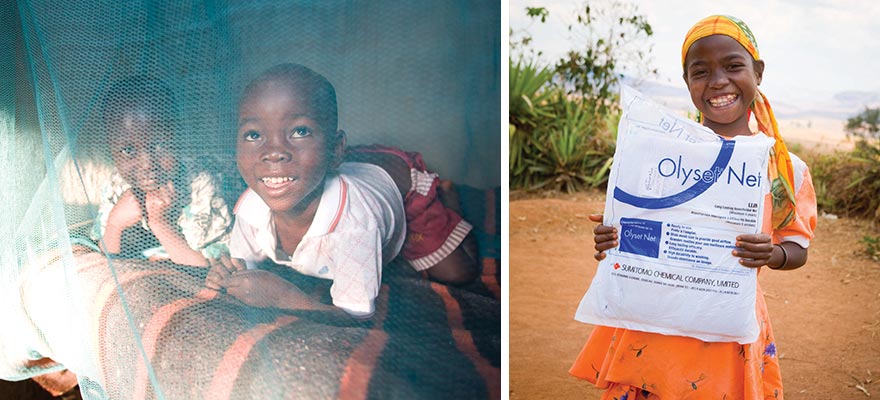Home > Highlighting JAPAN >Highlighting Japan July 2014>Summer in Japan
Highlighting JAPAN
Summer in Japan
Preventing Malaria with Mosquito Netting
Sumitomo Chemical's OlysetTM Net

Mosquito netting (kaya) was once so ubiquitous in Japanese households as to be considered a symbol of summer here. Mosquito nets were used to protect the inhabitants from mosquitos and other harmful insects, and in an age with no air conditioners those nets were essential for summer nights. While the younger generation in Japan may feel little affinity for them, mosquito nets developed in Japan are now saving lives in Africa.
The infectious disease malaria, contracted via a mosquito known as Anopheles lesteri, is now seen in over a hundred countries in subtropical and tropical regions around the world. According to the World Malaria Report 2013 of the World Health Organization (WHO), some two hundred million people contracted it in 2010 alone. About 660,000 people died of the disease, most of them children less than five years old in Sub-Saharan Africa.
Malaria not only takes the lives of children, it also destroys opportunities for work and education, increasing the socioeconomic burden. This results in the grim reality of poverty being exacerbated. Eradication of malaria is thus intimately linked to fighting poverty in Africa.
One researcher at Sumitomo Chemical took note of the problem in Africa and asked, "Using the know-how of this company, can't we do something about malaria?" And what he developed was OlysetTM Net.
OlysetTM Net is mosquito netting that incorporates an insect repellent called pyrethroid in highly durable polyethylene fibers. Mosquito netting used in the past was prepared by immersing it in a chemical solution. When washed, however, the chemical effect wore off, so it was not suitable for long-term use. In OlysetTM Net, on the other hand, the chemical leaches out from the fibers gradually thanks to a unique 'control-release' technology, so that even after repeated washings the effectiveness of the insect repellent does not disappear. In fact, OlysetTM Net can be used for more than five years.
At the core of this development was Sumitomo Chemical's technology for making insect-repellent screens using a proprietary method that combines resin processing and insecticides.
Additionally, considering that it was also to be used in tropical regions in Africa, air movement through the netting had to be maximized, so a specially designed weave was required.
In 2001, the WHO recognized its effectiveness as the world's first long-lasting mosquito netting, and recommended the use of OlysetTM Net to fight malaria. It is now used in over eighty countries in Africa and Southeast Asia afflicted by
the disease.
By using OlysetTM Net in a village in Kenya, where its effectiveness was researched, data revealed that a 50 percent incidence of people having the malarial protozoan organism in 2005 was reduced to 8 percent by 2008.
At first, these nets were donated and distributed through international organizations such as UNICEF (United Nations Children's Fund), but in 2003 the manufacturing technology was given gratis to A to Z Textile Mills, a manufacturer in Tanzania, and onsite production started in Africa itself (in 2007 a joint venture, Vector Health, was established). In Tanzania alone production capacity has reached close to thirty million units, creating employment for some seven thousand people.
Sales in supermarkets in Kenya began in October 2011 under the brand name OlysetTM CLASSIC. The objective was not only to develop a market by increasing sales channels, but also to raise prevention awareness among the people living there. Sumitomo Chemical uses part of its sales from the OlysetTMNet project to support education in Africa, such as by building schools and more.
Although the aim has been to exterminate malaria, a longtime commitment of support is required for that. The support provided by mosquito netting has been useful in its direct effect of saving lives, and also in showcasing how to make a sustained contribution through education as well as through developing markets.
© 2009 Cabinet Office, Government of Japan






